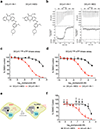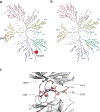Discovery of a selective inhibitor of doublecortin like kinase 1
- PMID: 32251410
- PMCID: PMC7246176
- DOI: 10.1038/s41589-020-0506-0
Discovery of a selective inhibitor of doublecortin like kinase 1
Abstract
Doublecortin like kinase 1 (DCLK1) is an understudied kinase that is upregulated in a wide range of cancers, including pancreatic ductal adenocarcinoma (PDAC). However, little is known about its potential as a therapeutic target. We used chemoproteomic profiling and structure-based design to develop a selective, in vivo-compatible chemical probe of the DCLK1 kinase domain, DCLK1-IN-1. We demonstrate activity of DCLK1-IN-1 against clinically relevant patient-derived PDAC organoid models and use a combination of RNA-sequencing, proteomics and phosphoproteomics analysis to reveal that DCLK1 inhibition modulates proteins and pathways associated with cell motility in this context. DCLK1-IN-1 will serve as a versatile tool to investigate DCLK1 biology and establish its role in cancer.
Figures




Similar articles
-
Small molecule kinase inhibitor LRRK2-IN-1 demonstrates potent activity against colorectal and pancreatic cancer through inhibition of doublecortin-like kinase 1.Mol Cancer. 2014 May 6;13:103. doi: 10.1186/1476-4598-13-103. Mol Cancer. 2014. PMID: 24885928 Free PMC article.
-
Structural Basis of Inhibition of DCLK1 by Ruxolitinib.Int J Mol Sci. 2021 Aug 6;22(16):8488. doi: 10.3390/ijms22168488. Int J Mol Sci. 2021. PMID: 34445192 Free PMC article.
-
Doublecortin-Like Kinase 1 (DCLK1) Regulates B Cell-Specific Moloney Murine Leukemia Virus Insertion Site 1 (Bmi-1) and is Associated with Metastasis and Prognosis in Pancreatic Cancer.Cell Physiol Biochem. 2018;51(1):262-277. doi: 10.1159/000495228. Epub 2018 Nov 19. Cell Physiol Biochem. 2018. PMID: 30453285
-
Research Progress of DCLK1 Inhibitors as Cancer Therapeutics.Curr Med Chem. 2022;29(13):2261-2273. doi: 10.2174/0929867328666210709110721. Curr Med Chem. 2022. PMID: 34254905 Review.
-
DCLK1 in gastrointestinal cancer: A driver of tumor progression and a promising therapeutic target.Int J Cancer. 2025 Jun 1;156(11):2068-2086. doi: 10.1002/ijc.35365. Epub 2025 Mar 8. Int J Cancer. 2025. PMID: 40056091 Review.
Cited by
-
CXCL12/CXCR7/β-arrestin1 biased signal promotes epithelial-to-mesenchymal transition of colorectal cancer by repressing miRNAs through YAP1 nuclear translocation.Cell Biosci. 2022 Oct 9;12(1):171. doi: 10.1186/s13578-022-00908-1. Cell Biosci. 2022. PMID: 36210463 Free PMC article.
-
Identification of targetable kinases in idiopathic pulmonary fibrosis.Respir Res. 2022 Feb 7;23(1):20. doi: 10.1186/s12931-022-01940-y. Respir Res. 2022. PMID: 35130915 Free PMC article.
-
DCLK1 autoinhibition and activation in tumorigenesis.Innovation (Camb). 2021 Nov 26;3(1):100191. doi: 10.1016/j.xinn.2021.100191. eCollection 2022 Jan 25. Innovation (Camb). 2021. PMID: 34977835 Free PMC article.
-
Targeted degradation of oncogenic KRASG12V triggers antitumor immunity in lung cancer models.J Clin Invest. 2024 Dec 24;135(2):e174249. doi: 10.1172/JCI174249. J Clin Invest. 2024. PMID: 39718828 Free PMC article.
-
Chemical Biology Toolkit for DCLK1 Reveals Connection to RNA Processing.Cell Chem Biol. 2020 Oct 15;27(10):1229-1240.e4. doi: 10.1016/j.chembiol.2020.07.011. Epub 2020 Aug 4. Cell Chem Biol. 2020. PMID: 32755567 Free PMC article.
References
-
- Fedorov O, Muller S & Knapp S The (un)targeted cancer kinome. Nat. Chem. Biol 6, 166–169 (2010). - PubMed
Publication types
MeSH terms
Substances
Grants and funding
LinkOut - more resources
Full Text Sources
Other Literature Sources
Medical
Molecular Biology Databases

